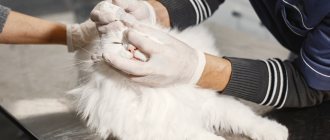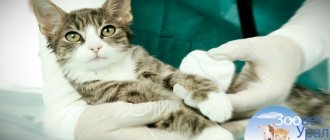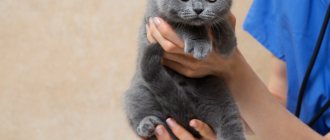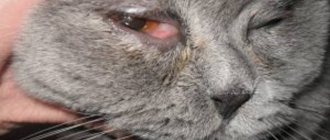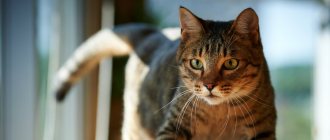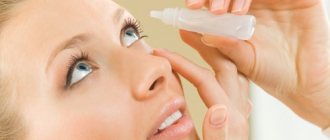Caring and loving “cat owners” have probably repeatedly noticed how their purrs sometimes “cry”, and therefore asked a natural question: why do the cat’s eyes water?
Tears help protect an animal’s eyes from dust and other foreign bodies, just like humans, in everyday life. That's why sometimes tears should appear in your cat's eyes.
It is considered natural in terms of physiology when a cat’s eyes water after sleep. He usually washes himself or you wipe the corners of his eyes with a dry cloth. Caring owners have made it a rule to periodically arrange “bath days” for their pets, carefully (so as not to damage the eyeball) by washing their eyes and ears with cosmetic pads or cotton swabs dipped in warm boiled water.
It’s another matter when the purring dog’s tearfulness is constantly observed, and this tearfulness is accompanied by a sad and lethargic appearance of the animal. Why do cats have watery eyes and what to do in such cases?
You should not perceive this process as natural, and also do not assume that in this case the purr will wash itself. “Killing” the infection at home by only washing your pet’s eyes with various disinfectants is also not advisable without the intervention of a veterinarian.
How to examine a cat?
Quite often, the appearance of tears in a cat's eyes indicates the presence of some kind of disease. It is important for the owner to pay attention to whether tears appeared for a limited time and then disappeared, or in the pet’s eyes the discharge is present throughout the day, or, what is much worse, not for several days.
- If the tear discharge is insignificant, appeared in the morning and quickly passed, then there is nothing to worry about, so there is no need to worry;
- If it is clear that the eyes “cry” for a long time, then you need to look for the cause of this phenomenon.
Before examining your pet, you need to clean your hands to prevent additional infection. Next, you need to pull down the upper eyelids on each eye. If the eyes are shiny and not clouded, the pupils are the same size, the cornea is noticeably transparent, and the back surface of both eyelids has a pale pink tint, then there are no problems with the animal’s eyes.
The fact that there are certain problems with the eyes can be judged by redness or swelling of the eyelids, clouding of the cornea.
If the animal’s eyes are difficult to open or there is a thin light film on the inner surface of the eyelid, then it is recommended to go to the veterinarian as soon as possible.
Differential diagnosis
Differential diagnosis is carried out, first of all, with conjunctivitis. Conjunctivitis often accompanies many ocular and periocular pathologies: primary keratitis (ulcerative and non-ulcerative forms), dry eye, blepharitis, uveitis, glaucoma, dacryocystitis. It is necessary to distinguish between hyperemia of episcleral and conjunctival vessels in order to differentiate dangerous eye diseases (such as glaucoma or uveitis) from superficial and less dangerous processes (for example, from superficial keratitis). [29], [30], [31], [32]
Causes and treatment
There are several common reasons why a cat's eyes may start to water.
Some foreign body has entered the eye. It could be a speck, a twig, a fluff, a midge or dirt. If something like this is discovered, you must first rinse the pet’s eyes under running water. Once the foreign object is washed away, you can use one percent tetracycline ointment to apply to the cat's upper eyelid area. It is recommended to take the animal to a veterinarian for consultation.
The pet has a weakened immune system. This happens if the kitten was separated from its mother too early. However, only a veterinarian can reliably determine whether this is the case. He will also develop a regimen for taking the required medications and correct the pet’s nutrition.
The presence of an allergic reaction, which is inherent in cats as well as in humans. The same thing that can act as an allergen can act as a human allergen: chemicals, dust, pollen, etc. In this case, it is imperative to contact a qualified specialist for consultation, since the owner will not be able to independently determine not only the allergy itself, but also the cause of its occurrence.
Worms are a fairly common reason why a cat's eyes may begin to water. To exclude this, it is necessary to regularly treat the animal for parasites.
Pet breed. Some cat breeds have a characteristic skull structure with deformed nasolacrimal ducts and a flattened nose. In this case, only washing the eyes every day helps, as well as special attention to hygiene procedures in such a risky area.
Diseases of cold origin. If your pet coughs and sneezes additionally, absorbs a lot of water, and begins to sleep much more, then it is quite possible to suspect a cold. It is not recommended to treat the animal yourself; you need to contact a specialized specialist.
Cat distemper also has discharge from the eyes as one of its symptoms. In addition, the appearance of pus, high fever, vomiting and diarrhea, and general weakness are noted. It is not allowed to treat a pet with such symptoms on your own.
Treatment of tearing in cats
The nature of the treatment depends entirely on the cause of the pathology. If problems are detected with the anatomical structure of the nasopharynx, resulting in lacrimation and difficulty breathing, the doctor may even prescribe surgical intervention. In other situations, treatment is not difficult.
If an allergic reaction is detected, you need to get rid of the allergen and prescribe antihistamines.
If there are injuries or a foreign object is found in the eye, the wound should be treated and the object removed.
If an infection is detected, your doctor may prescribe antiviral medications or antibiotics. It is important to understand that there are diseases that require not only local treatment, but also general treatment.
Cataracts, increased intraocular pressure, and keratitis are most often treated with drops. The drug and dosage are selected individually, taking into account the general condition of the animal.
Eye diseases accompanied by the production of tears
There are several different eye conditions in pets that cause tear production:
- Infection. If the eye is noticeably swollen and red, and there is discharge of pus, then the help of a veterinarian is definitely needed to prevent the development of feline conjunctivitis.
- Directly eye diseases, in particular glaucoma or cataracts. A clouded cornea in the first case or a whitened lens in the second are the most obvious symptoms of these diseases. Of course, you definitely need to go to a clinic for treatment.
- Diseases caused by fungi or viruses (such as toxoplasmosis or chlamydia) can only be cured by a veterinarian.
- Inflammation of the cornea can be identified by reddened and very watery eyes, on which a soapy film forms.
- Some breeds experience entropion of the eyelid - usually Sphynxes or Persians. The appearance of swollen eyes and suppuration in their eyes is a reason to visit a veterinarian as soon as possible.
- Eye injuries that a cat can get if it fights with its fellow tribesmen, hits itself, or gets caught on some branches. Wounds or other damage to the eyeballs are obvious symptoms of this injury. It is recommended to consult a veterinarian to determine the severity of the damage.
Symptoms
The disease is manifested by several symptoms: itching of the mucous membranes, sneezing, watery nasal discharge (rhinorrhea), and nasal congestion, and sometimes even conjunctivitis. With obstruction (obstruction syndrome of the human respiratory system), headaches often occur. Allergic rhinitis can lead to complications such as sinusitis.
The causes of rhinitis can be pollen, mold spores, wool, fluff and waste products of animals (cats, dogs, rodents), dust mites, cockroaches.
Asthma is a frequent accompaniment of allergic rhinitis, but it is not yet clear whether a false runny nose is the cause of asthma or whether both of these diseases are based on the same cause - the allergic process. With asthma accompanying hay fever, the patient may experience shortness of breath and a severe cough.
The color of the discharge from the eyes matters
It is important for the pet owner to carefully look at the color of the discharge coming from the eyes.
If they are transparent, similar to ordinary tears, then this may be due to the characteristics of the breed, mechanical irritation, or the occurrence of an allergic reaction.
If yellow or green discharge appears, in which pus is present, we can say that there is an infectious disease.
If a cat's eyes are watery red or brown, then there is a high probability that the cat is infected with worms.
When to contact a veterinarian
Examine the cat carefully. If the tears are clean and transparent, without any admixture of pus or blood, there are no signs of swelling, and the cat plays with pleasure and has an excellent appetite, there is nothing to worry about. Your pet does not require treatment, but only proper care.
A visit to the veterinarian is required if the following signs are detected:
- The cat doesn't eat well.
- Her snot is flowing.
- He often scratches his eyes.
- Cloudy or purulent tears.
- Dull eyes.
- The cat is too excited or, conversely, too lethargic.
- The cat's eye is swollen.
- There are deep scratches and cuts around the eyes.
In specialized veterinary clinics they will always be able to accurately determine the diagnosis and correctly state the cause of watery cat eyes.
The Scottish Fold cat's eyes are watery: why?
It was previously mentioned that certain breeds of pets have a non-standard nasolacrimal duct, and among them the British, Scottish and Persian breeds stand out. Due to such features, the lacrimal canal is not able to fully remove secretions, which are the norm for all other breeds. In this case, the excess comes out through the eyes. If this happens after the animal has slept, then there is no reason to worry. This phenomenon is normal from a physiological standpoint.
If your pet constantly produces tears, this is no longer considered normal, so you need to seek the help of a veterinarian to find out the reasons.
Such animals need to wash their eyes once a week or more often, and in some cases up to 2-3 times a day. With a normal level of discharge, it is quite enough to simply wipe them periodically.
If your cat's eyes often water, it is recommended to bring the animal to the veterinarian for a full examination.
Tags
watery eyes with eyes.Red eyes and one eye watering cloudy eye watery eyes watery eyes with watery eyes with watery eyes such tearing. one-sided watery eyes and watery eyes are the eyes of cats w cats in cats there are some cats brown the cats of all these cats have the eyes of cats wu cats of all and cats in cats ABOUT CATS Io cats about cats the cat is sick and the cat is wateryDiagnosis of a cat when If a cat sneezesA cat has one cat's eyes waterycats eyes watery
case of corneal entropionauthor of articleareairritation unanswerableworthnutritionlifeviolationsitebirdsproblemsread
Cat protection
A very correct approach is the use of hygienic methods that protect the animal from the need for treatment in the future. It is recommended to periodically wash your pet's eyes with a cotton swab dipped in warm water towards the spout.
If there is dried discharge on the eyes, then you need to carefully soften and remove it, and then rinse the eyes with a clean swab.
You cannot use the same swab to treat both eyes; you need to take a new one each time.
If your pet has watery eyes, you do not need to buy and apply drops or medications yourself without consulting a veterinarian, as this can make the animal sick.
Rules for washing and instilling eye drops
If one of the points of treatment for a cat is eye drops, then it is important to know how to carry it out while causing minimal discomfort to the pet.
For this you need:
- sterile pipette or syringe;
- product (drops, ointment) at room temperature;
- clean wipes or tampons;
- food to encourage and relieve stress in cats.
It is advisable to carry out the burial with an assistant who will help hold the frightened animal. The cat must be well secured. In extreme cases, it is tied with soft cloth.
With a moistened swab, wipe the pet's eye from the outer corner to the inner, removing crusts and drops of secreted liquid. Then the eye is wiped again with a clean napkin.
Now you can start instilling: open the cat’s eyes wide with the thumb and forefinger, after which the product is quickly instilled directly under the eyelid. Excess liquid is blotted with a napkin, then the cat is rewarded for its bravery and released.
Pregnant and small pets require a special approach. Cats expecting the birth of babies are rarely prescribed medications; rinsing is done with chamomile or calendula decoctions, a tea solution, and in extreme cases, tetracycline ointment is applied. Newborn kittens with high tear production are prescribed Bars or Anandin drops.
Preventive procedures
If there is no obvious problem at the moment, you can use the recommendations for prevention. A warm decoction of medicinal plants, which are also intended for humans, drops that do not contain an antibiotic, or green tea are suitable for this.
If your cat's eyes are watery due to an infectious disease confirmed by a veterinarian, then tetracycline ointment can be used.
To treat bacterial infections, “Diamond Eyes” drops or some of their analogues are used.
When should you start worrying?
- In the morning, the cat cannot open his eyes, as they are “covered” with pus and watery;
- The animal cannot clear its eyes on its own, or it does, but tears or other secretions accumulate again;
- Eyes are red/swollen/cloudy, etc. That is, they do not look normal and healthy.
- Painful symptoms are observed: an apathetic state and a dull look. The animal is looking for a calm and dark place and refuses to eat.
If you observe at least one of these symptoms, then this is an alarming sign. Take your pet and take it to the veterinarian, taking the certificates/documents in advance and remembering a few details.
Attention! No self-medication!
The main rule for cat owners is not to self-medicate, no matter how simple the problem may seem. Remember that any wrong action or inaction you take towards your pet can negatively affect its health.
It is always better to contact a competent specialist, for example, to the Murmansk veterinary clinic “Favorite”, where you can always get a full range of consultations, diagnosis and treatment of all cat diseases.
"Favorit" - professional care for your pet!
First aid for a pet at home
There are situations when it is impossible or very difficult to get to the veterinarian. In this case, the owner must provide first aid to his pet.
- Washing your eyes is a very important aspect. By washing your eyes, you relieve your baby's suffering. Eyes should be washed only with a warm solution using a cotton pad. After rinsing, your pet should apply an eye ointment, such as tetracycline.
Washing is performed by the following means:
- A decoction of medicinal chamomile;
- Boric acid solution;
- 0.02% furatsilin solution.
- Eye ointment. Before applying the ointment, you need to warm it in your hand. Cold ointment should never be applied to the affected area. The ointment should be applied as follows:
- The kitten should be placed on its side and held tightly. It is best if one person holds the pet while the other applies the medicine.
- Next, you need to carefully pull back the lower eyelid and gently apply the ointment.
- Then, you should massage the eyelid so that the medicine is distributed over the eye.
- You can also put special drops in your pet’s eyes. Which ones you need to find out at your veterinary pharmacy.
How to help your pet
Helping your pet can go in two directions: eliminating the cause and symptomatic relief of the condition. In order to eliminate the cause, in most cases a consultation with a veterinarian is necessary.
At home, you can carry out hygiene procedures and use eye drops. For rinsing, it is better to use saline solution (at a concentration of 0.9%) or special drops. At home, non-concentrated herbal decoctions (for example, chamomile) can be used for preventive rinsing. You need to rinse your eyes at least 2 times a day (morning and evening).
How to prevent lacrimation?
Owners are advised to examine their pets' eyes daily. They should have the same shape, be clear, and have no discharge or other signs of inflammation.
If you have a small kitten, you need to provide him with the necessary hygiene. You can wipe your eyes with a bandage containing warm boiled water or any antibacterial solution. Furacilin is perfect. You can also use special drops. If an adult cat does not take good care of its own hygiene, then conjunctivitis is possible. In this case, you can use ointment or drops containing chloramphenicol. If the problem does not resolve itself within a few days, it is worth taking the animal to the veterinarian. Long-haired cats sometimes need the fur around their eyes trimmed. It is also very important to monitor the claws so that the pet does not accidentally injure its eyes when washing. Food and hygiene products must be properly selected.
If the owner follows all these rules and contacts the veterinarian for routine examinations, he will be able to avoid any eye problems in his cat. It is important to understand that prevention is simpler than any treatment. Following the tips described above will keep your pet's eyes healthy and clear-eyed for many years!
Disease prevention
In order for your pet to get sick less often, he needs to take preventive measures, namely:
- A small pet should wash its eyes daily;
- When playing with an animal, it is necessary to take all measures so that the kitten does not get injured;
- All vaccinations must be done on time;
- The animal's nutrition must be correct and balanced;
- Take your pet to the vet regularly.
Caring for your pet is a very important aspect of pet care. After all, this is the only way your baby will grow up healthy and happy.
Viral or bacterial eye infection
A cat's eyes may become watery due to a viral or bacterial infection. If your pet's discharge has been going on for quite some time, and it has become thick, cloudy white or yellow, then most likely there is an infection in the eyes that is rapidly gaining momentum.
This could be conjunctivitis, toxoplasmosis, or herpetic infection. It is necessary to undergo an examination by a veterinarian in Murmansk. Ignoring these alarming symptoms can significantly weaken your cat's vision and even lead to blindness. The specialist will prescribe a series of tests to identify a hidden infection in the body and draw up a treatment plan for your pet.
Meaning of lacrimation
Tearing has two main functions: hydration and protection. Tears are primarily composed of water and electrolytes, but also contain small amounts of mucus and albumin. Thus, when the tear enters the outer part of the eyeball, it moisturizes the mucous membrane of the eye.
In addition, the production of tears is a natural way of flushing the eyes. With the current of tears, all foreign particles (including dust and microorganisms) are removed from the eye.
Genetics and breed
The cause of increased lacrimation may also lie in genetics. There are breeds of cats in which constant lacrimation is caused by features of the anatomical structure, and is considered within normal limits. These are breeds of Scots, British, Persians, and exotics.
All cats, whose skull structure is characterized by a short, flat muzzle and large eyes, have narrowed tear ducts and small tear grooves, which is why fluid constantly flows from the edges of the eyelids, forming characteristic furrows.
Still, you shouldn’t blame the whole problem on genetics if your pet is one of the above breeds. It is better to once again consult with a veterinarian to determine the correct diagnosis.
Establishing diagnosis
Before starting treatment, it is imperative to conduct a diagnosis that will help identify the true cause of excessive lacrimation and carry out effective treatment therapy. Only a veterinarian can conduct a correct and thorough examination.
Important! Before going to the veterinarian, be sure to prepare a pet card, which should indicate all vaccinations, anthelmintic treatments, and past illnesses. It is advisable to write down symptoms of malaise and other suspicious signs on a piece of paper.
Sometimes the veterinarian may be interested in the following important questions at the appointment:
- how long the symptoms last;
- how did the first symptoms of tearing from the eyes appear and the peculiarities of the course of this condition, for example, did two eyes immediately begin to water at the same time, or vice versa, first one began, and then the other, and whether there are other additional symptoms;
- when the last procedures to eliminate helminths, fleas, ticks and other parasites were carried out.
To make an accurate diagnosis, the veterinarian will definitely take a urine and stool test. It is advisable to already have the research material with you before going to the doctor. Also, at the appointment, he will definitely take mucus from the eye for examination; for this reason, there is no need to first rinse the pet’s eyes with various solutions.
